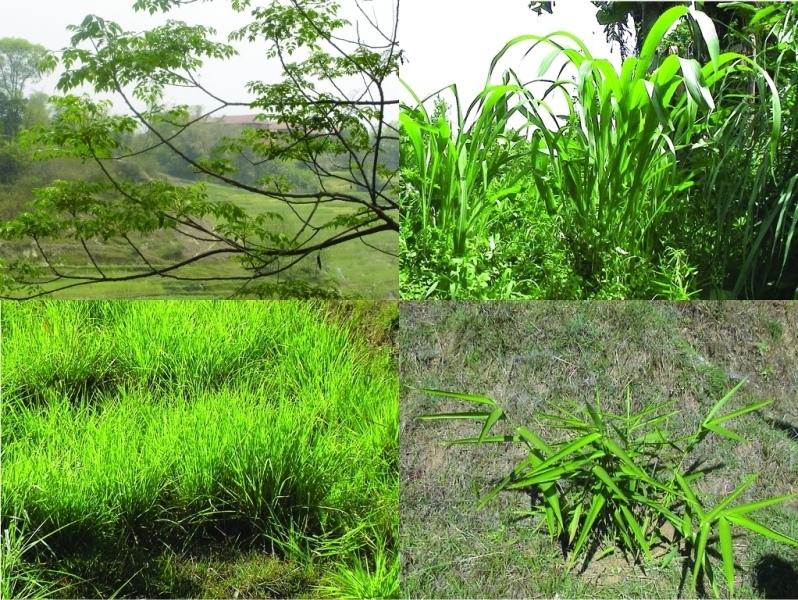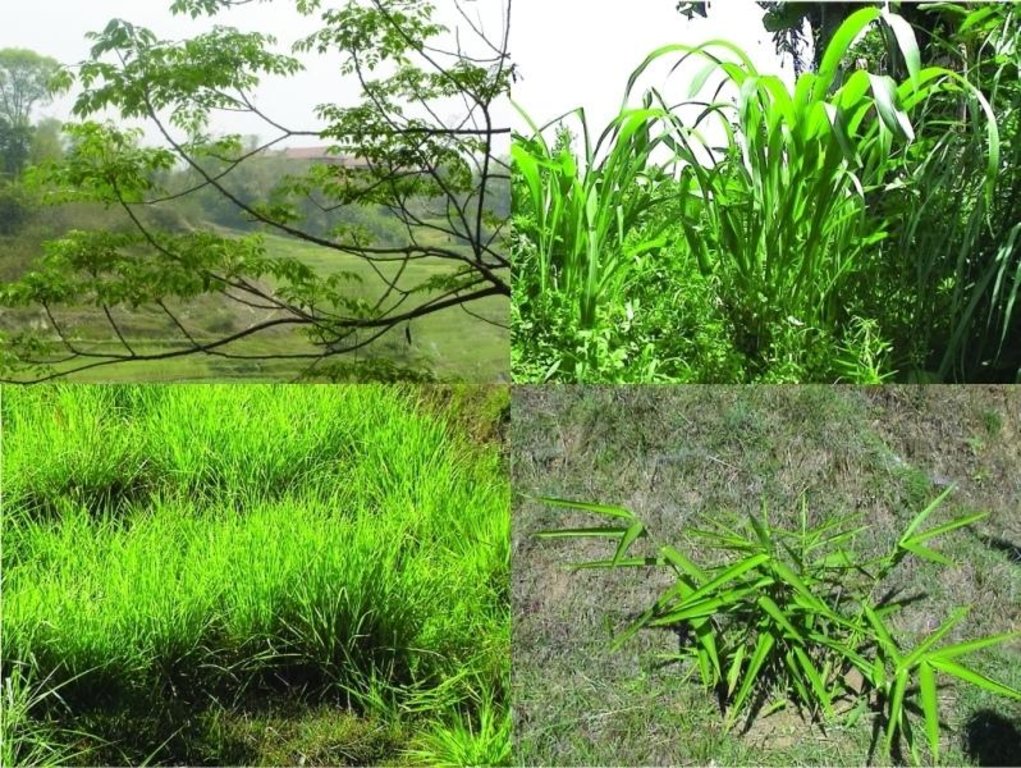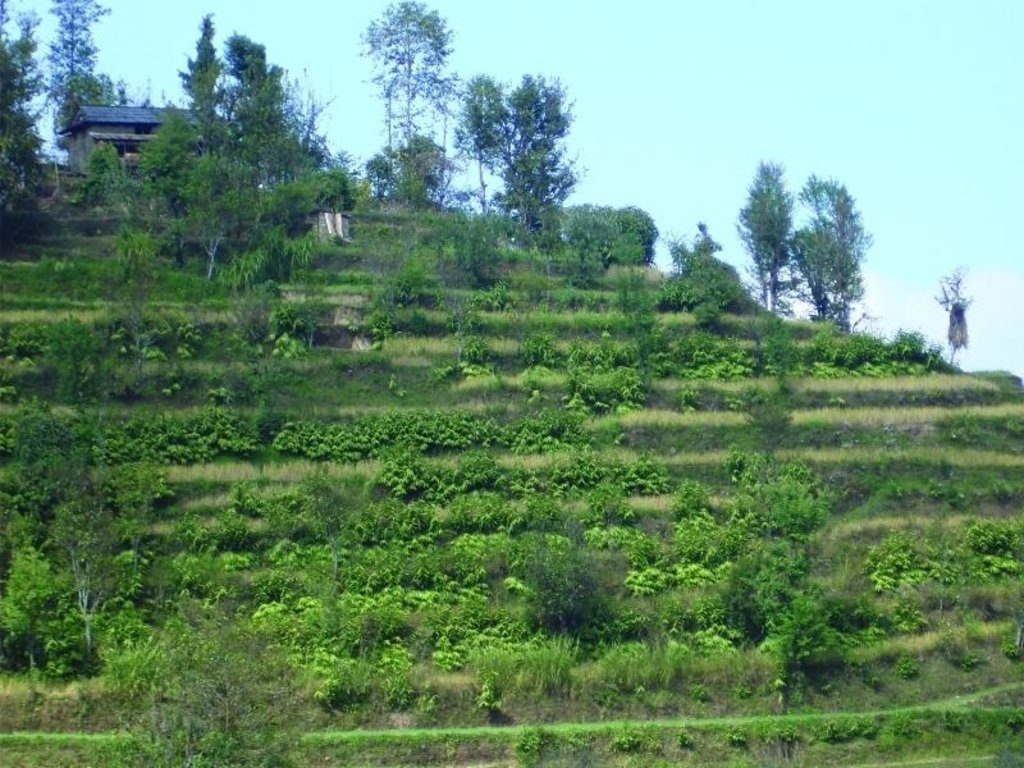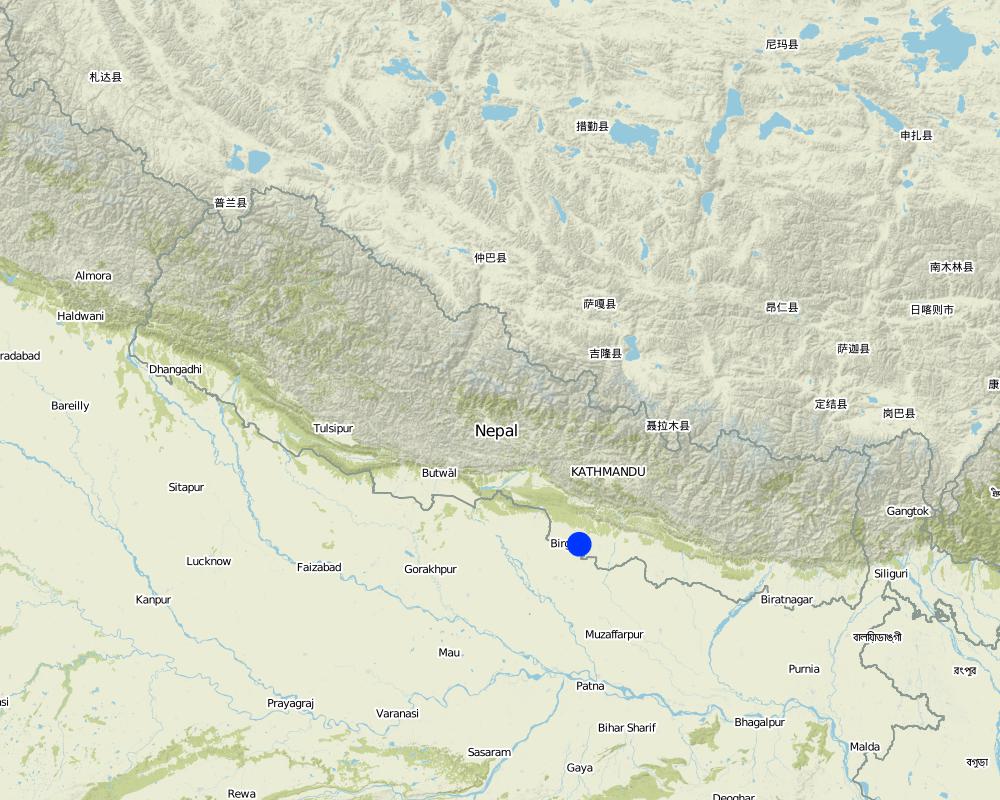Cultivation of fodder and grasses [เนปาล]
- ผู้สร้างสรรค์:
- การอัพเดท:
- ผู้รวบรวม: Richard Allen
- ผู้เรียบเรียง: –
- ผู้ตรวจสอบ: David Streiff, Alexandra Gavilano
Dale ghans tatha bhuin ghans prawardhan
technologies_1757 - เนปาล
ดูส่วนย่อย
ขยายทั้งหมด ย่อทั้งหมด1. ข้อมูลทั่วไป
1.2 รายละเอียดที่ติดต่อได้ของผู้รวบรวมและองค์กรที่เกี่ยวข้องในการประเมินและการจัดเตรียมทำเอกสารของเทคโนโลยี
ผู้เชี่ยวชาญ SLM:
Director
Soil Management Directorate, Department of Agriculture
เนปาล
ผู้เชี่ยวชาญ SLM:
Team Leader
Sustainable Soil Management Programme
เนปาล
ชื่อของโครงการซึ่งอำนวยความสะดวกในการทำเอกสารหรือการประเมินเทคโนโลยี (ถ้าเกี่ยวข้อง)
Sustainable Soil Management Programme, Nepal (SSMP)ชื่อขององค์กรซึ่งอำนวยความสะดวกในการทำเอกสารหรือการประเมินเทคโนโลยี (ถ้าเกี่ยวข้อง)
Department of Agriculture, Soil Management Directorate, Hariharbhawan Lalitpur (doasoil) - เนปาลชื่อขององค์กรซึ่งอำนวยความสะดวกในการทำเอกสารหรือการประเมินเทคโนโลยี (ถ้าเกี่ยวข้อง)
HELVETAS (Swiss Intercooperation)1.3 เงื่อนไขการใช้ข้อมูลที่ได้บันทึกผ่านทาง WOCAT
ผู้รวบรวมและวิทยากรหลักยอมรับเงื่อนไขเกี่ยวกับการใช้ข้อมูลที่ถูกบันทึกผ่านทาง WOCAT:
ใช่
1.5 Reference to Questionnaire(s) on SLM Approaches (documented using WOCAT)

Farmer field schools on integrated plant nutrient systems [เนปาล]
Participatory and collaborative learning through the farmer field school approach
- ผู้รวบรวม: Richard Allen

Farmer-to-farmer diffusion [เนปาล]
Wider diffusion of sustainable soil management technologies through a demand responsive farmer-to-farmer diffusion approach
- ผู้รวบรวม: Richard Allen
2. การอธิบายลักษณะของเทคโนโลยี SLM
2.1 การอธิบายแบบสั้น ๆ ของเทคโนโลยี
คำจำกัดความของเทคโนโลยี:
Cultivation of fodder crops on marginal lands and terrace risers
2.2 การอธิบายแบบละเอียดของเทคโนโลยี
คำอธิบาย:
Fodder plays a major role in the crop-livestock-manure-soil nutrient cycle on farms in the middle mountains of the Himalayas. Livestock convert fodder shrubs and grasses from the forest, crop residues, and other fodder into manure through digestion. However, in the middle hills of Nepal the lack of availability of good quality fodder often limits not only, the productivity of livestock, but also reduces the nitrogen content of animal dung if, for example, only cereal crop residues, are fed to the animals.
In earlier times, livestock were left to graze in the forests and on community lands. The animals sought out their own food and were only assembled for milking and to protect them from wild animals. With the introduction of stall-feeding, the demand for fodder has increased greatly with a subsequent large increase in women’s workload as it is they who are responsible for collecting the fodder.
Most fodder is collected in forest areas, and most livestock manure is applied to arable land, in particular to rainfed fields. This results in a net transfer of nutrients from forest areas to arable lands. It is estimated that, in this way, about 3 to 7 ha of forest land is needed to maintain 1 ha of arable land without degrading the state of the forest. In addition to reducing the availability of forest resources, the widespread closure of community forests has diminished access to fodder during certain times of the year. All this is putting serious pressure on the remaining unprotected forest resources.
Marginal lands and terrace risers offer an opportunity to reduce this pressure. The planting of grasses and shrubs suitable for fodder on these areas not only increases fodder availability but also reduces erosion and landslides that originate in these areas. If leguminous fodder species are planted, they increase soil fertility by increasing the nitrogen content in soils.
2.3 รูปภาพของเทคโนโลยี
2.5 ประเทศภูมิภาค หรือสถานที่ตั้งที่เทคโนโลยีได้นำไปใช้และได้รับการครอบคลุมโดยการประเมินนี้
ประเทศ:
เนปาล
ระบุการกระจายตัวของเทคโนโลยี:
- กระจายไปอย่างสม่ำเสมอในพื้นที่
Map
×3. การจัดประเภทของเทคโนโลยี SLM
3.1 วัตถุประสงค์หลักของเทคโนโลยี
- ปรับปรุงการผลิตให้ดีขึ้น
- ลด ป้องกัน ฟื้นฟู การเสื่อมโทรมของที่ดิน
3.2 ประเภทของการใช้ที่ดินในปัจจุบันที่ได้นำเทคโนโลยีไปใช้

พื้นที่ปลูกพืช
- การปลูกพืชล้มลุกอายุปีเดียว
Annual cropping - Specify crops:
- fodder crops - grasses
- fodder crops - other
แสดงความคิดเห็น:
Major land use problems (compiler’s opinion): Increasing livestock numbers causing the degradation of unprotected forest areas. The closure of large areas of community managed forests to grazing and fodder collection is putting more pressure on unprotected forest areas and increasing the demand for alternative sources of fodder and better quality fodder.
3.5 กลุ่ม SLM ที่ตรงกับเทคโนโลยีนี้
- การจัดการปลูกพืชร่วมกับปศุสัตว์
- การปรับปรุงดิน / พืชคลุมดิน
3.6 มาตรการ SLM ที่ประกอบกันเป็นเทคโนโลยี

มาตรการอนุรักษ์ด้วยวิธีพืช
- V2: หญ้าและไม้ยืนต้น
3.7 รูปแบบหลักของการเสื่อมโทรมของที่ดินที่ได้รับการแก้ไขโดยเทคโนโลยี

การเสื่อมโทรมของดินทางด้านเคมี
- Cn (Fertility decline): ความอุดมสมบูรณ์และปริมาณอินทรียวัตถุในดินถูกทำให้ลดลงไป (ไม่ได้เกิดจากสาเหตุการกัดกร่อน)
3.8 การป้องกัน การลดลง หรือการฟื้นฟูความเสื่อมโทรมของที่ดิน
ระบุเป้าหมายของเทคโนโลยีกับความเสื่อมโทรมของที่ดิน:
- ลดความเสื่อมโทรมของดิน
4. ข้อมูลจำเพาะด้านเทคนิค กิจกรรมการนำไปปฏิบัติใช้ ปัจจัยนำเข้า และค่าใช้จ่าย
4.1 แบบแปลนทางเทคนิคของเทคโนโลยี
ข้อมูลจำเพาะด้านเทคนิค (แบบแปลนทางเทคนิคของเทคโนโลยี):
Technical knowledge required for field staff / advisors: low
Technical knowledge required for land users: low
Main technical functions: increased availability of fodder, improved manure quality & increased quantity of manure, increased soil fertility
Secondary technical functions: nitrogen fixation (if leguminous species are planted)
Trees/ shrubs species: badahar (Artocarpus lakoocha), dudhilo (Ficus nemoralis), nemaro (Ficus roxburghi), tank (Bauhinia p
Grass species: stylo (Stylosanthes spp.), dinanath (Penisetum spp.), molasses, Napier grass NB21 (Penisetum purpure)
4.2 ข้อมูลทั่วไปเกี่ยวกับการคำนวณปัจจัยนำเข้าและค่าใช้จ่าย
ระบุสกุลเงินที่ใช้คำนวณค่าใช้จ่าย:
- USD
ระบุค่าเฉลี่ยของค่าจ้างในการจ้างแรงงานต่อวัน:
2.00
4.3 กิจกรรมเพื่อการจัดตั้ง
| กิจกรรม | Timing (season) | |
|---|---|---|
| 1. | Establish nursery for saplings/seedlings, and procure seed of appropriate species | |
| 2. | Transplant at appropriate time on wasteland areas around houses and terrace risers as given in the Agroforestry Training Manual (NAF, SSMP 2002) |
4.4 ค่าใช้จ่ายของปัจจัยนำเข้าที่จำเป็นสำหรับการจัดตั้ง
| ปัจจัยนำเข้า | หน่วย | ปริมาณ | ค่าใช้จ่ายต่อหน่วย | ค่าใช้จ่ายทั้งหมดต่อปัจจัยนำเข้า | %ของค่าใช้จ่ายที่ก่อให้เกิดขึ้นโดยผู้ใช้ที่ดิน | |
|---|---|---|---|---|---|---|
| แรงงาน | Nursing seedling | Persons/day | 3.0 | 2.0 | 6.0 | 100.0 |
| วัสดุด้านพืช | Seedlings | unit | 1.0 | 4.0 | 4.0 | 100.0 |
| ค่าใช้จ่ายทั้งหมดของการจัดตั้งเทคโนโลยี | 10.0 | |||||
| Total costs for establishment of the Technology in USD | 10.0 | |||||
4.5 การบำรุงรักษาสภาพหรือกิจกรรมที่เกิดขึ้นเป็นประจำ
| กิจกรรม | ช่วงระยะเวลา/ความถี่ | |
|---|---|---|
| 1. | Depending on species, newly established trees and shrubs need to be pruned, pollarded, or coppiced; grasses need no further agronomic practices | |
| 2. | Replace dead plants and ones that failed to establish |
4.6 ค่าใช้จ่ายของปัจจัยนำเข้าและกิจกรรมที่เกิดขึ้นเป็นประจำที่ต้องการการบำรุงรักษา (ต่อปี)
| ปัจจัยนำเข้า | หน่วย | ปริมาณ | ค่าใช้จ่ายต่อหน่วย | ค่าใช้จ่ายทั้งหมดต่อปัจจัยนำเข้า | %ของค่าใช้จ่ายที่ก่อให้เกิดขึ้นโดยผู้ใช้ที่ดิน | |
|---|---|---|---|---|---|---|
| แรงงาน | Replace dead plants | Persons/day | 3.0 | 2.0 | 6.0 | 100.0 |
| ค่าใช้จ่ายทั้งหมดของการบำรุงรักษาสภาพเทคโนโลยี | 6.0 | |||||
| Total costs for maintenance of the Technology in USD | 6.0 | |||||
แสดงความคิดเห็น:
Cost as in January 2007
4.7 ปัจจัยสำคัญที่สุดที่มีผลกระทบต่อค่าใช้จ่าย
ปัจจัยสำคัญที่สุดที่มีผลกระทบต่อค่าใช้จ่ายต่างๆ:
Cost ofseeds or saplings/seedlings depends on species.
5. สิ่งแวดล้อมทางธรรมชาติและของมนุษย์
5.1 ภูมิอากาศ
ฝนประจำปี
- < 250 ม.ม.
- 251-500 ม.ม.
- 501-750 ม.ม.
- 751-1,000 ม.ม.
- 1,001-1,500 ม.ม.
- 1,501-2,000 ม.ม.
- 2,001-3,000 ม.ม.
- 3,001-4,000 ม.ม.
- > 4,000 ม.ม.
ข้อมูลจำเพาะ/ความคิดเห็นเรื่องปริมาณน้ำฝน:
Annual rainfall: Also 2000-3000 mm
เขตภูมิอากาศเกษตร
- ชื้น
Thermal climate class: subtropics
5.2 สภาพภูมิประเทศ
ค่าเฉลี่ยความลาดชัน:
- ราบเรียบ (0-2%)
- ลาดที่ไม่ชัน (3-5%)
- ปานกลาง (6-10%)
- เป็นลูกคลื่น (11-15%)
- เป็นเนิน (16-30%)
- ชัน (31-60%)
- ชันมาก (>60%)
ธรณีสัณฐาน:
- ที่ราบสูง/ที่ราบ
- สันเขา
- ไหล่เขา
- ไหล่เนินเขา
- ตีนเนิน
- หุบเขา
ระดับความสูง:
- 0-100 เมตร
- 101-500 เมตร
- 501-1,000 เมตร
- 1,001-1,500 เมตร
- 1,501-2,000 เมตร
- 2,001-2,500 เมตร
- 2,501-3,000 เมตร
- 3,001-4,000 เมตร
- > 4,000 เมตร
ความคิดเห็นและข้อมูลจำเพาะเพิ่มเติมเรื่องสภาพภูมิประเทศ:
Slopes on average: Also moderate (6-10%), rolling (11-15%) and hilly (16-30%)
Landforms: Also footslopes
Altitudinal zone: Also 1000-1500 m a.s.l. and 1500-2000 m a.s.l.
5.6 ลักษณะของผู้ใช้ที่ดินที่นำเทคโนโลยีไปปฏิบัติใช้
แนวทางการตลาดของระบบการผลิต:
- เพื่อการยังชีพ (หาเลี้ยงตนเอง)
- ทำการค้า/การตลาด
เป็นรายบุคคล/ครัวเรือน:
- เป็นรายบุคคล/ครัวเรือน
ระบุลักษณะอื่นๆที่เกี่ยวข้องของผู้ใช้ที่ดิน:
Off-farm income specification: In most farm households, off-farm income plays at least a minor and increasingly a major role. Occasional opportunities for off-farm income present themselves in the form of daily labour wages. Some households’ members receive regular salaries, whilst an increasing number of Nepalis are working in India, the Middle East, Malaysia, and elsewhere and sending remittance incomes home.
5.7 Average area of land used by land users applying the Technology
- < 0.5 เฮกตาร์
- 0.5-1 เฮกตาร์
- 1-2 เฮกตาร์
- 2-5 เฮกตาร์
- 5-15 เฮกตาร์
- 15-50 เฮกตาร์
- 50-100 เฮกตาร์
- 100-500 เฮกตาร์
- 500-1,000 เฮกตาร์
- 1,000-10,000 เฮกตาร์
- >10,000 เฮกตาร์
5.8 กรรมสิทธิ์ในที่ดิน สิทธิในการใช้ที่ดินและสิทธิในการใช้น้ำ
กรรมสิทธิ์ในที่ดิน:
- รายบุคคล ไม่ได้รับสิทธิครอบครอง
- รายบุคคล ได้รับสิทธิครอบครอง
สิทธิในการใช้ที่ดิน:
- เช่า
- รายบุคคล
แสดงความคิดเห็น:
sharecropping between owner and tenant
6. ผลกระทบและสรุปคำบอกกล่าว
6.1 ผลกระทบในพื้นที่ดำเนินการ (On-site) จากการใช้เทคโนโลยี
ผลกระทบทางด้านเศรษฐกิจและสังคม
การผลิต
การผลิตพืชผล
แสดงความคิดเห็น/ระบุ:
due to shading effect
การผลิตพืชที่ใช้เลี้ยงปศุสัตว์
คุณภาพพืชที่ใช้เลี้ยงปศุสัตว์
รายได้และค่าใช้จ่าย
ภาระงาน
แสดงความคิดเห็น/ระบุ:
mainly for women
ผลกระทบทางด้านเศรษฐกิจและสังคมอื่น ๆ
milk production
livestock health
manure availability
ผลกระทบด้านนิเวศวิทยา
ความหลากหลายทางชีวภาพของพืชและสัตว์
การจัดการศัตรูพืชและโรคพืช
แสดงความคิดเห็น/ระบุ:
some of the new species provide inputs for organic pest management
ผลกระทบด้านนิเวศวิทยาอื่น ๆ
erosion from terrace bunds and marginal lands
need for free grazing
incidence of rodents and snakes
6.2 ผลกระทบนอกพื้นที่ดำเนินการ (Off-site) จากการใช้เทคโนโลยี
pressure on forest resources
6.4 การวิเคราะห์ค่าใช้จ่ายและผลประโยชน์ที่ได้รับ
ผลประโยชน์ที่ได้รับเปรียบเทียบกับค่าใช้จ่ายในการจัดตั้งเป็นอย่างไร (จากมุมมองของผู้ใช้ที่ดิน)
ผลตอบแทนระยะสั้น:
ด้านบวก
ผลตอบแทนระยะยาว:
ด้านบวก
ผลประโยชน์ที่ได้รับเปรียบเทียบกับค่าใช้จ่ายในการบำรุงรักษาหรือต้นทุนที่เกิดขึ้นซ้ำอีก เป็นอย่างไร (จากมุมมองของผู้ใช้ที่ดิน)
ผลตอบแทนระยะสั้น:
ด้านบวก
ผลตอบแทนระยะยาว:
ด้านบวก
6.5 การปรับตัวของเทคโนโลยี
Of all those who have adopted the Technology, how many did so spontaneously, i.e. without receiving any material incentives/ payments?
- 51-90%
แสดงความคิดเห็น:
Comments on spontaneous adoption: 80% of the Sfarmers exposed to this technology by SSMP adopted it. 30% farmers with or without direct reference to fodder promotion) have planted a variety of new fodder species About 10% of local farmers not involved in SSMP have adopted the technology.
6.7 จุดแข็ง / ข้อได้เปรียบ / โอกาสของเทคโนโลยี
| จุดแข็ง / ข้อได้เปรียบ / โอกาสในทัศนคติของผู้รวบรวมหรือวิทยากรหลัก |
|---|
| Improves fodder quantity and quality with a positive impact on livestock health and productivity |
| Increased fodder availability near the house reduces the workload of women to collect fodder and grass for livestock |
| Feeding of improved fodder and grasses improves quality of farmyard manure and thereby reduces need for mineral fertilise |
| Different species provide source of mulching and staking material |
6.8 จุดอ่อน / ข้อเสียเปรียบ / ความเสี่ยงของเทคโนโลยีและวิธีการแก้ไข
| จุดอ่อน / ข้อเสียเปรียบ / ความเสี่ยงในทัศนคติของผู้รวบรวมหรือวิทยากรหลัก | มีวิธีการแก้ไขได้อย่างไร |
|---|---|
| In places fodder grasses and shrubs have increased the incidence of rodents and snakes | select appropriate species; pruning and pollarding to manage height of the plants |
| Shading effect on fi eld crops | only plant such species on wastelands or along river banks |
| Host of insect pests | |
| Some species (e.g. bamboo, eucalyptus) have alleopathic effects that inhibit the growth of crop and other plants |
7. การอ้างอิงและการเชื่อมต่อ
7.1 วิธีการและแหล่งข้อมูล
7.2 การอ้างอิงถึงสิ่งตีพิมพ์
หัวข้อ, ผู้เขียน, ปี, หมายเลข ISBN:
NAF; SSMP (2002) Agroforestry Training Manual (in Nepali). Kathmandu: Nepal Agroforestry Foundation and Sustainable Soil Management Programme
ชื่อเรื่อง ผู้เขียน ปี ISBN:
SSMP
ลิงก์และโมดูล
ขยายทั้งหมด ย่อทั้งหมดลิงก์

Farmer field schools on integrated plant nutrient systems [เนปาล]
Participatory and collaborative learning through the farmer field school approach
- ผู้รวบรวม: Richard Allen

Farmer-to-farmer diffusion [เนปาล]
Wider diffusion of sustainable soil management technologies through a demand responsive farmer-to-farmer diffusion approach
- ผู้รวบรวม: Richard Allen
โมดูล
ไม่มีโมดูล





